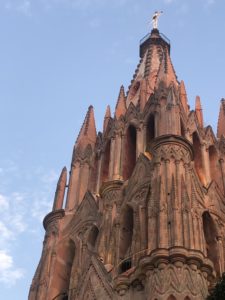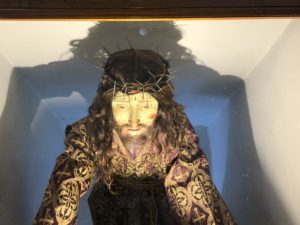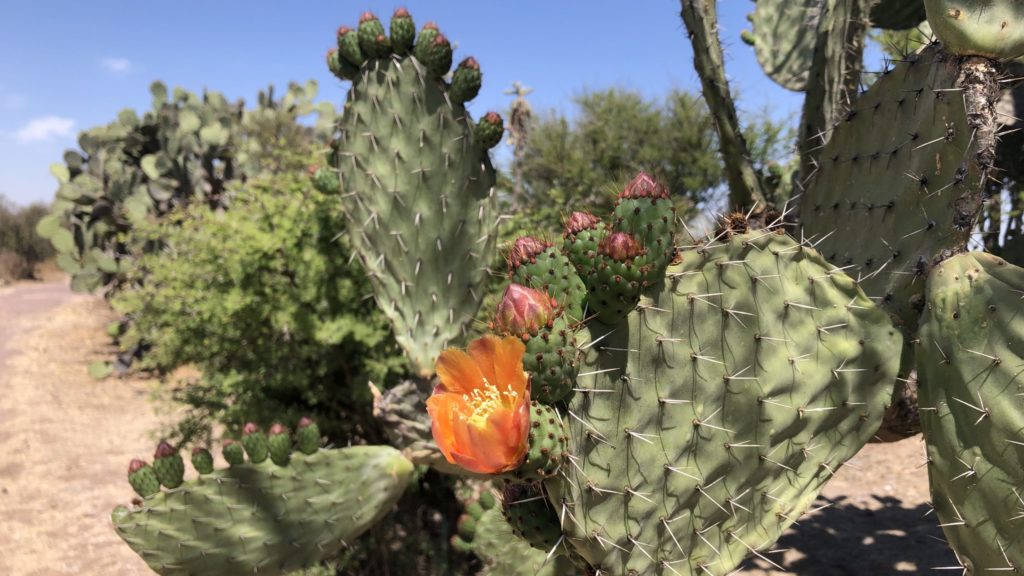For years I’d heard of the charm and beauty of San Miguel de Allende, a small Spanish colonial city a few hours north of Mexico City. At long last, partly at the urging of certain people in my circle that I should “take a vacation,” I went.
The weather was perfect: 80 degrees or so, sunny, and with a breeze. My hotel featured an inner courtyard overgrown with vines and copa de oro flowers, a bubbling stone fountain, and a room with high ceilings, tiled floors, and wood-shuttered windows.
The rooftop terrace overlooked jacaranda trees in full bloom and the warm pink spire of Parroquia de San Miguel Arcángel, the cathedral around which the life of the city revolves.
Designated a World Heritage site in 2008, San Miguel indeed drips with charm. Founded in 1542 by the Franciscan monk Juan de San Miguel, the latter part of the city’s name, added in 1826, honors Ignacio Allende, a hero-martyr of the revolution for Mexican independence against Spain.
The buildings are painted old rose, deep gold, and brick red. Doorways are adorned with garlands of dried flowers, balconies stream trails of colored ribbons, and roofs are topped by vintage terra cotta pots of geraniums, agaves, and succulents. The narrow streets are cobblestone. There are no traffic lights.

If you’re a check-off-the-box, travel-highlights sort of person, San Miguel might not be for you. There’s a toy museum. There’s a botanical garden up above town. Other than that, there’s not a whole lot to “do” — and what an incredible, boundless gift.
You can walk, one of my personal favorite activities.
You can wander around eating cups of delicious fresh fruit — papaya, cantaloupe, watermelon, pineapple — sprinkled with chili and lime.
You can sit on a bench in the sun, sipping a cold drink and staring idly into space.
You can visit the churches — cavernous, cool, dusty, and dim — another of my favorite activities. Festooned with folk art, flowers, and gaudy chandeliers, the overall effect is of heaven — as envisioned by a child. A statue of the Blessed Virgin Mary stands on a cloud-like cape of aquamarine sequins that a trapeze artist might wear. St. Michael the Archangel, in a bejeweled belt and glittering boots, might evoke a Las Vegas lion tamer.
At the same time, there is no lack of showing Christ’s human suffering: Everywhere Jesus is lacerated, scourged, bound, crawling, bloody, in agony, dying, dead.
These splendid sanctuaries are often empty, save for some sainted soul with a bucket quietly mopping the floors; a stray person, head in hands, praying; or maybe a tourist couple taking selfies.
The architecture looks jerry-rigged, unplumbed, and held together with spackling compound, as if the crumbling arches and angel-bedecked stone overhangs might collapse at any minute.
Somehow this seemed emblematic of the Church itself: gloriously triumphant, but ever-precarious.
Best of all, at dusk the whole city, it seems, gathers in the central garden across from La Parroquia.
Yes, some or much of it was for the benefit of us tourists: the tall papier-mâché figures tottering around the square or the mariachis in their pointed patent leather boots and embroidered sombreros.
Still, the overwhelming majority of the people in attendance were clearly locals.
Ice cream and cotton candy vendors crowded around. Children frolicked. Parents chatted. When I sat down on a vacant bench, a family almost instantly crowded around me with warm smiles. This is the way it should be, with our natural urge to give thanks, to rest for a bit, to gather with family, friends, and neighbors, and welcome the night. How seldom in the United States have I experienced this phenomenon of people being embraced, accommodated, and incorporated into the Mystical Body.
Mexico, I decided toward the end of my week, is entirely female: the warmth, food and flowers, that maternal embrace, the buildings close to the ground. People’s lives are in one way available to all the world — the shutters open to a bodega or a papelería — but behind those same shutters, that close in the heat of the afternoon and after dark, also hidden. You don’t just barge in. There are depths, and there are secrets.
On my last day, on a narrow street above Benito Juárez Park, I came across a tall tree full of nesting egrets. That night, I walked up to the plaza and enjoyed the crowd for a while.
Then I headed across the street, up the stone stairs, and into La Parroquia.

It took a minute for my eyes to adjust from the bright late afternoon sunlight to filtered gloom. There it all was: the gory statues, the corpse effigies in glass caskets, the bloodied, crucified Christ. From outside wafted the sound of honking taxi horns, the shouts of children, and the strains of “Volver Volver.”
Way up front there were about 25 people huddled and on the altar glittered a small gold monstrance.
Don’t you get scared traveling alone? I’m often asked. What about the cartels? Did you know the state of Guanajuato is under an advisory?
I fingered the rosary in my pocket and from a pew near the back knelt, along with the others, in adoration. In the sequined embrace of Our Lady, under the lion-tamer wings of St. Michael the Archangel, I’d never felt safer.

